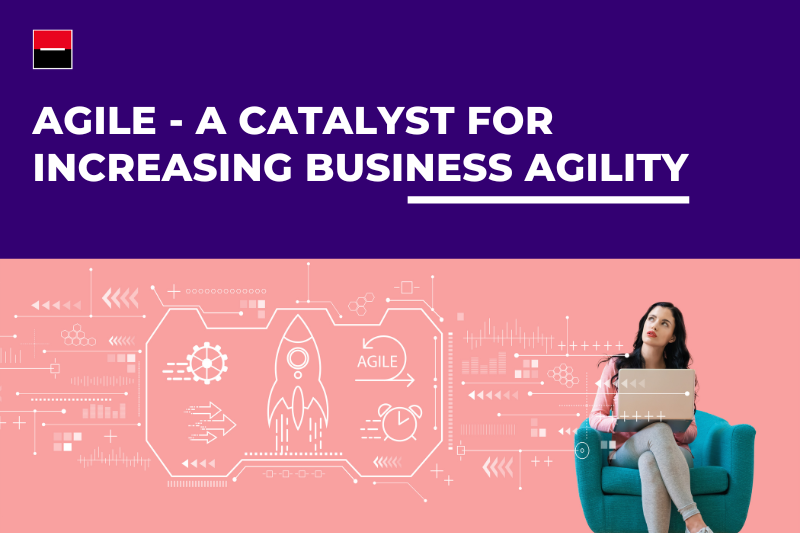Agile – A Catalyst For Increasing Business Agility

Citește în continuare

Leverage On The Past, Explore The Present, Imagine The Future
“To improve is to change; to be perfect is to change often.” Winston Churchill
In today’s fast-paced and ever-changing business landscape where organizations are constantly seeking ways to adapt, innovate, and stay competitive, this classical quote keeps emphasizing the need for flexibility, adaptability, continuous improvement, and evolution.
According to Wikipedia, “business agility refers to rapid, continuous, and systematic evolutionary adaptation and entrepreneurial innovation directed at gaining and maintaining competitive advantage. Business agility can be sustained by maintaining and adapting the goods and services offered to meet with customer demands, adjusting to the marketplace changes in a business environment, and taking advantage of available human resources.”
Now, more than ever, technology is reshaping the industries, the business models, the expectations of the customers or users and businesses are embarking on transformational journeys to stay relevant and competitive. Therefore, to navigate this new landscape towards fulfilling their vision & purpose, the organizations are required to reshape their culture, strategy, processes, and practices.
One method that has emerged as a powerful catalyst for increasing business agility is Agile. Agile is not just a set of principles and practices for software development; it has evolved into a mindset that can transform the way businesses operate across various industries.
Why Agile?
Agile is firmly rooted in an adaptive and customer-centric mindset defined by the Four Values & Twelve Principles (Agile Manifesto) that manifest a new way of working & leading. Unlike traditional, rigid business approaches, Agile embraces change as a fundamental driver of growth and improvement.
It prioritizes the customer’s needs and focuses on delivering value consistently in a responsive and iterative manner. This mindset shift is crucial for organizations looking to stay relevant and competitive in a world characterized by constant disruption, rapid & dynamic technological advancements, and ever-evolving customer expectations.
Key Ingredients For Increasing Business Agility
Like many of you out there, I enjoy eating good food. I’m fascinated by how combining a range of ingredients could lead to a delicious food or an average one.
There are certain foods that in different countries have similar ingredients and still taste differently. The proportion of each ingredient in the recipe, or the way they are cooked will tell a different tasting story depending on the place where that food is cooked.
In the culture of a country, the food is an element that contributes to its very identity.
Even though cooking a recipe is part of the obvious domain, creating a new recipe can be included in the complex domain, being achieved in an iterative and incremental way through continuous experimentation to arrive to a final product shaped for delighting the customers.
Similarly (but at a completely different scale), on top of the continuous experimentation and the iterative and incremental approach, the businesses would need an entirely different mindset, culture and style of leadership to be adopted for them to become agile organizations and enhance their business agility.
In my experience, to accomplish this successfully, there are some key ingredients that the organizations need to focus on:
Focus on the customerAgile places the customer as the very center of the development.In an Agile organization, customer engagement & feedback is not only encouraged but is actively sought at every stage of development. This customer-centric approach ensures that the final product or service delivered aligns closely with the customer’s needs and expectations.By involving customers early and encouraging frequent feedback loops, businesses can reduce the risk of building something that isn’t fit for purpose, thus enhancing the customer satisfaction & retention. | Organize around valueFocus on the items that bring the highest value first.When creating or maintaining a product, there can be a large number of features that can be imagined, that are different in terms of how much value each of them could provide.Nevertheless, the Agile principle of simplicity, advocates that it’s essential to maximize the amount of work not done.That means that the focus will always be only on the features that bring the highest value to the customers first, therefore implementing this principle will lead to customers receiving the most meaningful and valuable product for their needs. |
Iterative and incremental cyclesHaving short iterative cycles allow for continuously releasing small incremental updates to the products or services which results in a reduced time to market compared to a traditional approach.In this manner the businesses can respond early to changing market conditions.Operating with maximum transparency with the help of live information radiators and swiftly validating assumptions, plans are adapted according to the reality and risks are addressed early and often which leads to a better risk management, reducing the probability to have costly failures. | Cross-functional and self-managing teamsThese are empowered and autonomous teams with all the roles needed to fulfill the customer requirements and deliver value frequently in collaboration with Business Stakeholders & Product Management Teams.This collaborative approach fosters open communication, knowledge sharing and a sense of ownership among team members.Such teams operate on a high degree of collaboration at all levels and focus keeping a high quality of the product. |
Continuous improvementThis is a core ingredient of an iterative and incremental approach. The events designed for retrospection help the teams at all levels reflect on what works well (to celebrate and amplify) and on what can be improved (to take actions for implementing the improvement opportunities discovered).That would positively impact the individuals and interactions, processes, tools, planning, collaboration etc. enhancing the ways of working which gets to improved effectiveness and efficiency over time leading to better products and services | |
Leadership
Leadership plays an important role in creating high performing organizations through teams that are autonomous, empowered, self-managed and focused on delivering value consistently.
By creating and nurturing an environment where it’s safe to fail instead of designing failsafe strategies they open a space for the collective intelligence to thrive and create living products adaptable to everchanging market conditions.
By empowering and trusting the teams, supporting the people to be autonomous, developing their skills towards mastery, and communicating a clear purpose, leadership will tap on unleashing the intrinsic motivation of the employees leading to higher commitment, increased accountability and outstanding results when developing products.
Embrace the Journey: Parting Reflections
Agile doesn’t come with a written recipe and the list of ingredients above can be enriched as each business has an unique context and the organization’s transformation journey will need to tailor the approach as per that very context.
Though not a silver bullet that can address all organizational problems, Agile has evolved from its origins in software development to become a powerful catalyst for increasing business agility across various industries. By embracing Agile values, principles and adopting Agile frameworks, organizations can respond to change more rapidly, enhance collaboration, and deliver customer-centric solutions. The benefits of increased business agility are clear, making Agile a key driver of success in today’s dynamic and competitive business environment.
Working in a global organization with a history of more than 150 years in delivering value for the customers provides a rich insight on how adaptability and continuous improvement put into practice and the attention to customer needs can help navigate through a changing world.
What would your successful Agile adoption look like?
My name is Laurentiu Bold, I am an Agile Coach with more than a decade of expertise in various Agile roles.
With a passion for fostering agility and driving efficiency, I am always looking to have a significant impact on the teams I work with.
For the past five years, I am part of the Societe Generale Global Solution Centre, collaborating with teams in IT Filliere serving a diverse range of Business Lines.
My mission? Elevate their Agile maturity, making them more effective and efficient.
Currently, I am focusing on serving Retail banking Division, an important Service Unit responsible for transforming information systems to meet the needs and expectations of French retail banking customers.
Societe Generale Global Solution Centre in Romania is a business solution centre for Societe Generale, one of the largest European financial groups. It provides high-quality professional services for 35+ countries in the following areas: Finance & Accounting, Human Resources, Information Technology, Know Your Customer and Compliance.
OTHER EVENTS THAT MIGHT INTEREST YOU



